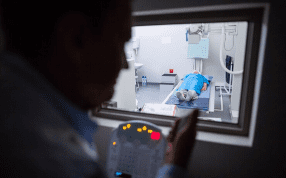麻醉深度监测市场专注于通过优化麻醉管理来提高手术过程中患者的安全性。这是通过利用脑电图 (EEG)、双谱指数 (BIS) 和熵监测等各种技术实现的。基于 EEG 的监测评估大脑中的电活动,而 BIS 和熵监测则使用从 EEG 信号中得出的特定指数来量化麻醉深度。主要目标是防止麻醉不足(这可能导致患者意识不清)以及麻醉过度(可能带来并发症的风险)。通过提供对麻醉深度的实时洞察,这些技术旨在确保患者保持无意识和无痛,从而最大限度地减少并发症的可能性并改善手术结果。全球麻醉深度监测市场预计到 2030 年将达到 306,001.97 万美元,在 2023-2030 年预测期内的复合年增长率为 5.9%。
保持信息灵通,保持健康!要了解有关市场的更多信息,请访问此处, https://www.databridgemarketresearch.com/zh/reports/global-depth-of-anesthesia-monitoring-market
医院: 医院是麻醉深度监测市场的主导部分,预计将占据45.89%的可观市场份额。它是麻醉深度监测系统的主要最终用户之一。它们是综合性医疗机构,提供广泛的医疗服务,包括各种外科手术。医院进行不同复杂程度和专业的手术,因此对准确和先进的麻醉监测的需求至关重要。它对麻醉监测系统的持续投资,体现了对患者安全的可靠承诺,以及整合尖端技术以提高麻醉管理质量
门诊手术中心: 门诊手术中心 (ASC) 是专门为门诊手术设计的设施。与医院不同,ASC 专注于提供当日手术服务,患者通常不会过夜。在 ASC 中,程序通常没有医院中执行的程序复杂。 ASC 中的麻醉深度监测对于确保门诊手术期间患者的舒适度和安全非常重要。这些中心可以使用根据其具体需求和门诊手术性质量身定制的麻醉监测系统
诊所: 诊所是提供医疗服务(包括咨询、检查和治疗)的医疗机构。虽然诊所可能不会在现场进行大型外科手术,但它们可能会进行小型外科手术或需要麻醉的手术。诊所麻醉监测的深度对于确保在此类手术期间适当施用和监测麻醉至关重要。诊所的规模和专业化程度各不相同,麻醉监测技术的使用取决于其提供的服务范围

增强患者安全:持续监测麻醉深度可确保精确控制,降低麻醉不足和过度的风险,最终增强手术过程中患者的安全

优化麻醉管理:医疗保健提供者可以根据准确的麻醉深度信息进行实时调整,从而优化麻醉剂量并改善患者治疗效果

缩短恢复时间:微调麻醉水平有助于更快、更顺利地从麻醉中苏醒,有助于缩短术后恢复时间并改善患者的整体恢复体验

成本效益:通过避免过度使用麻醉并最大限度地减少并发症,麻醉深度监测可能会节省医疗机构的成本,使其成为具有成本效益的解决方案

定制患者护理:个性化麻醉管理使医疗保健专业人员能够根据每位患者的具体需求定制麻醉方案,促进个性化和更有效的护理

最大限度地减少副作用:准确的监测有助于最大限度地减少与麻醉相关的副作用,例如术后恶心和呕吐,从而带来更舒适和积极的患者体验

改善麻醉意识管理:监测麻醉深度有助于预防麻醉意识事件,使患者在手术期间恢复意识,从而改善患者的整体健康状况
在亚太地区,由于人们对麻醉不利影响的认识不断提高,中国在麻醉监测市场的深度上占据主导地位。 2022年该市场价值为3430万美元,预计到2030年将达到6255万美元,2023年至2030年的预测期间复合年增长率为7.8%。中国的主导地位植根于人们对麻醉重要性的日益认识监测患者安全。随着医疗保健投资的增加、医疗技术的进步以及对患者福祉的关注,中国的市场动态不断增加,所有这些都促进了该地区对复杂深度麻醉监测解决方案的需求不断增长。
探索中国在麻醉监护市场的主导地位,点击此处获取见解,
https://www.databridgemarketresearch.com/zh/reports/asia-pacific-depth-of-anesthesia-monitoring-market
在北美,由于麻醉监测设备的需求大幅增长,美国预计将主导全球麻醉深度监测市场。美国医疗保健系统的先进实践和主要市场参与者的战略举措有助于其在北美地区的主导地位。预计到2030年,该市场将达到1.5098亿美元,较2022年的8987万美元的估计值显着增长,复合年增长率为6.7%。这种增长凸显了人们日益认识到麻醉监测在确保手术过程中患者安全、与不断发展的医疗实践保持一致并强调先进技术在医疗保健中的整合方面的关键作用。
了解为什么美国麻醉监护市场不断增长。在这里阅读完整的市场洞察, https://www.databridgemarketresearch.com/zh/reports/north-america-depth-of-anesthesia-monitoring-market
麻醉监测市场的深度成为提高手术干预期间患者安全的关键力量。通过利用脑电图、BIS 和熵监测等技术,医疗机构,特别是医院,体现了对精确麻醉管理的承诺。美国市场的显着增长和中国在亚太地区的主导地位凸显了全球对这些进步的接受,预示着未来手术的特点是风险最小化、结果优化和患者护理的个性化方法。展望未来,在持续的技术进步和对精确性、安全性和个性化患者体验的坚定不移的推动下,麻醉深度监测市场的发展轨迹充满希望。当创新与同情心相遇时,每一步都有助于在动态的医疗保健领域创造更健康、更安全的明天。
联系我们,了解行业巨头的最新创新以及此类有趣的报告, https://www.databridgemarketresearch.com/zh/contact